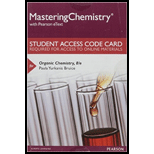
Concept explainers
(a)
Interpretation:
The value of
Concept introduction:
The amount of heat consumed or given off during the course of a reaction is known as enthalpy of reaction. Heat is given off when bonds are formed and heat is consumed when bonds are broken.
Heat is one form of energy.
The amount of energy required to break a
(b)
Interpretation:
The value of
Concept introduction:
The amount of heat consumed or given off during the course of a reaction is known as enthalpy of reaction. Heat is given off when bonds are formed and heat is consumed when bonds are broken.
Heat is one form of energy.
The amount of energy required to break a chemical bond is referred to as bond dissociation enthalpy.
(c)
Interpretation:
It should be identified that whether the given reactions (addition of HCl to ethene and addition of dihydrogen to ethene) are exothermic or endothermic in nature.
Concept introduction:
The amount of heat consumed or given off during the course of a reaction is known as enthalpy of reaction. Heat is given off when bonds are formed and heat is consumed when bonds are broken.
Heat is one form of energy.
The amount of energy required to break a chemical bond is referred to as bond dissociation enthalpy.
A reaction with a negative
A reaction with a positive
(d)
Interpretation: It should be identified that whether the given reactions (addition of HCl to ethene and addition of dihydrogen to ethene) are exergonic or endergonic in nature.
Concept introduction:
The amount of heat consumed or given off during the course of a reaction is known as enthalpy of reaction (H). Heat is given off when bonds are formed and heat is consumed when bonds are broken.
Heat is one form of energy.
The amount of energy required to break a chemical bond is referred to as bond dissociation enthalpy.
The mathematical relationship between enthalpy (H) and free energy (G) is,
In an exergonic reaction the products have a lower free energy than it consumes.
In an endergonic reaction the product have a higher free energy than it consumes.
Trending nowThis is a popular solution!

Chapter 5 Solutions
Organic Chemistry Study Guide and Solutions Manual, Books a la Carte Edition (8th Edition)
- presented by Morallen Lig Intermine the hand product for the given mution by adding atoms, bonds, nonhonding diarion panda скуль Step 3: Comp the draw the product Step 2: Agama workup Compithe 429 ملولةarrow_forwardReaction A 0,0arrow_forwardpresented by Morillon Leaning Predict the organic product for the min кусур HSC Adithane carved arnown to come than that to the condon slchroruis in acid in in aquishri with ноюarrow_forward
- 6.15PM Sun Mar 30 K Draw the major product of this reaction. Include any relevant stereochemistry. Ignore inorganic byproducts. Problem 1 of O H [PhзPCH2CH3]*C|¯ NaH Drawing > Q Atoms, Bonds and Draw or tap a nearrow_forward8:17 PM Sun Mar 30 Draw the major product of this reaction. Ignore inorganic byproducts. HSCH2CH2CH2SH, BF3 Probler Drawing Ato Bonds Clarrow_forwardpresented by Mr L How the coprion. (Il Done in no wraction, dew the starting redential) доarrow_forward
- 8:16 PM Sun Mar 30 K Draw the major product of this reaction. Ignore inorganic byproducts. Proble 1. CH3MgBr 2. H3O+ F Drawingarrow_forwardо но оarrow_forwardName the major organic product of the following action of 4-chloro-4-methyl-1-pentanol in neutral pollution 10+ Now the product. The product has a molecular formula f b. In a singly hain, the starting, material again converts into a secule with the molecular kormula CIO. but with comply Draw the major organic structure inhalationarrow_forward
- Macmillan Learning Alcohols can be oxidized by chromic acid derivatives. One such reagent is pyridinium chlorochromate, (C,H,NH*)(CICTO3), commonly known as PCC. Draw the proposed (neutral) intermediate and the organic product in the oxidation of 1-butanol by PCC when carried out in an anhydrous solvent such as CH₂C₁₂. PCC Intermediate OH CH2Cl2 Draw the intermediate. Select Draw Templates More с H Cr о Product Draw the product. Erase Select Draw Templates More H о Erasearrow_forwardIf I have 1-bromopropene, to obtain compound A, I have to add NaOH and another compound. Indicate which compound that would be. A C6H5 CH3arrow_forwardProvide the reagents for the following reactions.arrow_forward
 Chemistry: The Molecular ScienceChemistryISBN:9781285199047Author:John W. Moore, Conrad L. StanitskiPublisher:Cengage Learning
Chemistry: The Molecular ScienceChemistryISBN:9781285199047Author:John W. Moore, Conrad L. StanitskiPublisher:Cengage Learning Introductory Chemistry: A FoundationChemistryISBN:9781337399425Author:Steven S. Zumdahl, Donald J. DeCostePublisher:Cengage Learning
Introductory Chemistry: A FoundationChemistryISBN:9781337399425Author:Steven S. Zumdahl, Donald J. DeCostePublisher:Cengage Learning Chemistry & Chemical ReactivityChemistryISBN:9781337399074Author:John C. Kotz, Paul M. Treichel, John Townsend, David TreichelPublisher:Cengage Learning
Chemistry & Chemical ReactivityChemistryISBN:9781337399074Author:John C. Kotz, Paul M. Treichel, John Townsend, David TreichelPublisher:Cengage Learning Chemistry & Chemical ReactivityChemistryISBN:9781133949640Author:John C. Kotz, Paul M. Treichel, John Townsend, David TreichelPublisher:Cengage Learning
Chemistry & Chemical ReactivityChemistryISBN:9781133949640Author:John C. Kotz, Paul M. Treichel, John Townsend, David TreichelPublisher:Cengage Learning



